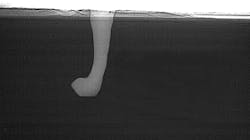X-ray laser pinpoints how defects occur in additive manufacturing
Pittsburgh, PA and Lemont, IL – A known problem in additive manufacturing (also known as 3D printing) is tiny gas pockets in the final product, which can lead to cracks and other failures. Recognizing this, a team of researchers from Carnegie Mellon University and the Argonne National Laboratory has identified how and when these gas pockets form, as well as a methodology to predict their formation, which could dramatically improve the 3D printing process.
The scientists used the extremely bright high-energy x-rays at Argonne’s Advanced Photon Source (APS), a DOE Office of Science User Facility, to take ultrafast video and images of a process called laser powder-bed fusion (LPBF), in which lasers are used to melt and fuse material powder together.
The lasers, which scan over each layer of powder to fuse metal where it is needed, create the finished product. Defects can form when pockets of gas become trapped into these layers, causing imperfections that could lead to cracks or other breakdowns in the final product.
Until now, manufacturers and researchers did not know much about how the laser drills into the metal, producing cavities called vapor depressions, but they assumed that the type of metal powder or strength of laser were to blame. As a result, manufacturers have been using a trial-and-error approach with different types of metals and lasers to seek to reduce the defects. Research shows that these vapor depressions exist under nearly all conditions in the process, no matter the laser or metal. Even more important, the research shows how to predict when a small depression will grow into a big and unstable one that can potentially create a defect.
By using highly specialized equipment at Argonne’s APS, the researchers watched what happens as the laser moves across the metal powder bed to create each layer of the product.
Under perfect conditions, the melt pool shape is shallow and semicircular, called the conduction mode. But during the actual printing process, the high-power laser, often moving at a low speed, can change the melt pool shape to something like a keyhole in a warded lock: round and large on top, with a narrow spike at bottom (FIGURE). Such keyhole mode melting can potentially lead to defects in the final product.
This image, taken under the synchrotron at Argonne National Laboratory, shows a keyhole void forming during the metal 3D printing process; during laser powder bed fusion, a 3D printer drills a hole into the metal.
“Based on this research, we now know that the keyhole phenomenon is more important, in many ways, than the powder being used in additive manufacturing,” says Ross Cunningham, a recent graduate from Carnegie Mellon University and one of the co-first authors of this paper. “Our research shows that you can predict the factors that lead to a keyhole—which means you can also isolate those factors for better results.”
The research shows that keyholes form when a certain laser power density is reached that is sufficient to boil the metal. This, in turn, reveals the critical importance of the laser focus in the additive manufacturing process, an element that has received scant attention so far, according to the research team.
The keyhole phenomenon was able to be viewed with such details because of the scale and specialized capability developed at Argonne, explains Tao Sun, an Argonne physicist and an author on the paper. “The intense high-energy x-ray beam at the APS is key to discoveries like this,” he adds.
The research team believes this research could motivate makers of additive manufacturing machines to offer more flexibility when controlling the machines and that the improved use of the machines could lead to a significant improvement in the final product. In addition, if these insights are acted upon, the process for 3D printing could get faster.
Full details of the work appear in the journal Science.
